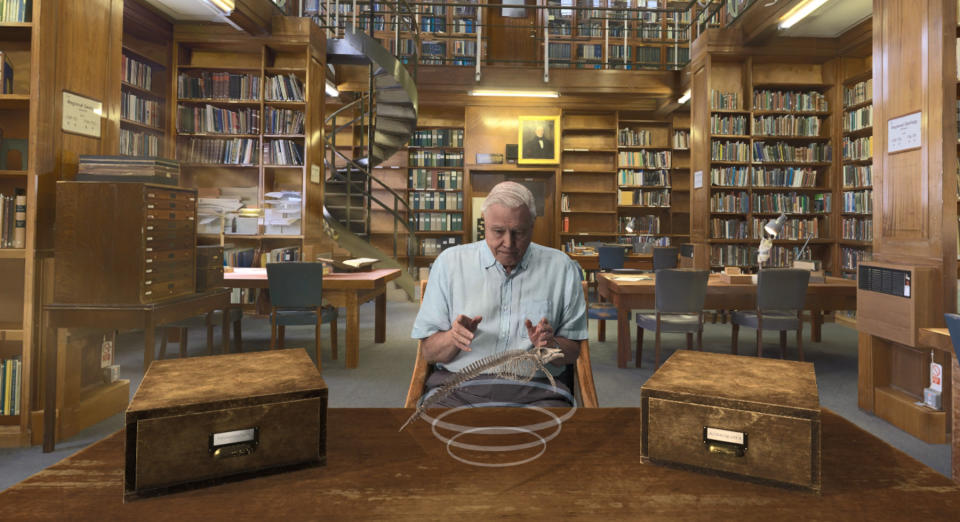Engadget has been testing and reviewing consumer tech since 2004. Our stories may include affiliate links; if you buy something through a link, we may earn a commission. Read more about how we evaluate products.
Sky VR's interactive museum visit deserves a bigger audience
David Attenborough shows you some of the London Natural History Museum's rarest specimens in 'Hold the World.'

Sir David Attenborough first lent his silky narrator's voice to the medium of VR when he teamed up with London's Natural History Museum for a special exhibit on the earth's prehistoric oceans. And now, several years later, the institution and Sir Dave have collaborated once again on a VR experience commissioned by European media-and-telecommunications company Sky. Hold the World offers an interactive look at a few of the museum's more interesting specimens, from the huge blue whale skeleton that hangs in the building's main entrance hall down to a tiny rat flea. Naturally, there's an educational aspect, with a lifelike hologram of Attenborough telling you all about the artifact as if he were sitting right there. But there's a catch: You'll have to be a Sky customer to try it out when it launches this spring.
A ton of tech went into developing all the different parts of the experience. The nine specimens featured in Hold the World were scanned to create the high-fidelity 3D models you interact with. Using whatever VR controllers you have at hand, you can pick them up, enlarge and shrink them with the equivalent of a pinch-to-zoom gesture, and move them around to get at the focal points that trigger classic Attenborough explanations of what you're looking at. You can also bang them on the table in front of you for a satisfying crack if you're childish like me. When you've finished the lesson portion, the skeletons and fossils come alive in a sort of finale, where they appear as animated, life-size versions of what you had in your hand a second ago.

During these sessions, Sir Dave sits across from you in hologram form, talking you through the specimens in his usual energetic style. He looks almost human. In order to be inserted into the experience, Attenborough traveled to one of Microsoft's mixed reality studios in the States to be filmed from every conceivable angle in a green-screen bubble. What I found most interesting about the whole thing, though, was the scene setting. You find different artifacts in different areas of the museum: the labs, libraries and archives inside the huge museum building that are reserved for research and not accessible to the visiting public. These are re-created in extremely fine, fascinating detail, thanks to photogrammetry. A team came in and took hundreds upon hundred of photos of the spaces, which software subsequently stitched together to create the virtual 3D space.
You can theoretically spend as much time as you want in these hidden parts of the museum, but rush through it and you can see all there is to see in about 20 minutes. That's not to say those 20 minutes aren't engaging and informative, with Hold the World certainly offering some educational-meets-entertainment value. But that wasn't my final thought on the whole experience. Instead, I came away feeling that something of this nature should be accessible, which it isn't.

To promote the Hold the World experience, Sky and the Natural History Museum put on a big evening event after public visiting hours were over, featuring demo stations, general introductions and a Q&A with Sir Dave himself, as well as people from the various teams that pulled it all together. There was plenty of talk of democratizing the museum, letting people "touch" specimens usually buried in the archives or safe behind glass cases. The educational value of Hold the World and VR as a medium was discussed, but I felt the whole PR program danced around the fact that this is a commercial endeavor for a limited audience.
When Hold the World launches, sometime in the next few months, it'll be available only to Sky's pay-TV, broadband and mobile customers (at last count, that's 23 million across five European countries). The list of supported hardware is relatively long -- Google's Daydream View, Samsung's Gear VR, the Oculus Rift and Microsoft's Mixed Reality headsets -- but it's not as if the entirety of Sky's subscriber base are going to have a compatible device in their homes.

Sky is shouting about Hold the World because it's the new, flagship experience that'll mark the "relaunch" of Sky VR. In one of its roles as a broadcaster, Sky's been making VR content for a while now; primarily 360-degree videos in the realms of news, sports, the arts and cultural events. This secondary push includes a new Sky VR app -- which you can log in to only if you've signed up to Sky's VIP loyalty program, by the way -- including more diverse material and a commitment to one new VR release each month.
Sky is perfectly within its rights to commission exclusive VR experiences for its existing customers (and to entice new ones), of course. But when you see, for example, what Google's Arts and Culture division is doing -- working with institutions all over the world, including the Natural History Museum, to create VR and other digital resources -- it seems a shame that something as educational, engaging and lovingly developed as Hold the World should be reduced to a Sky subscriber perk.

